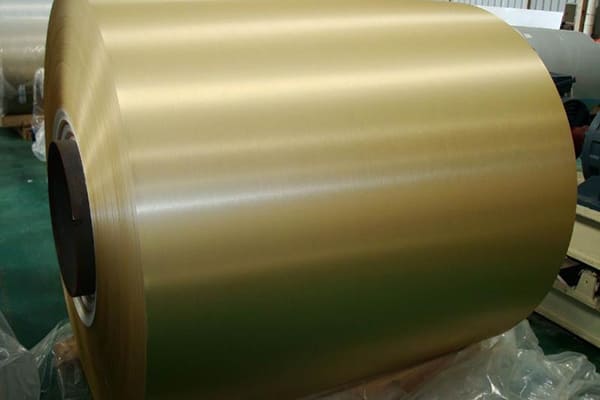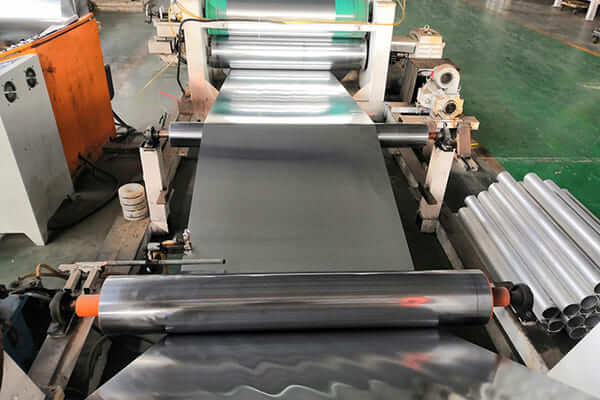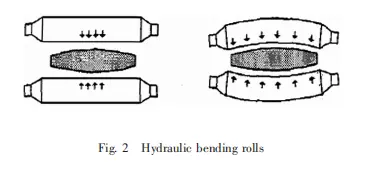In the process of rolling aluminum foil for cigarettes, the roughness and convexity process parameters of the rolling mill working roll are the decisive factors affecting the quality of aluminum foil products
Aluminum foil is light in weight and exhibits excellent properties in terms of corrosion resistance, moisture resistance, and UV resistance. It is also recyclable, easy to bend and print, and has good thermal stability. Therefore, it is widely used in cigarettes, medicine, household, electronics and other fields. Using aluminum foil packaging: ① Save a lot of resources; ② Improve the grade and aesthetics of packaging, thereby effectively promoting the consumption and application of aluminum foil.

Aluminum foil for cigarettes
Cigarette packaging is a very important part of cigarette production and the last process. In the entire process of cigarette production, circulation and consumption, the quality of packaging materials plays a very important role in maintaining the quality of cigarette products, promoting consumption, and guiding consumption. Compared with other commodities, cigarette packaging materials require greater specificity, no odor, should be non-toxic and harmless to the human body, and should have moisture resistance and isolation properties. Aluminum foil has all the properties required for cigarette packaging. In the process of application in the cigarette industry, it is often supplied with a thickness of (6~6.5) μm. In the subsequent process, it needs to go through many steps such as compounding, coloring, pressing, drying, etc. to finally form qualified packaging materials. In order to ensure the yield rate of the subsequent compounding step, the quality of the aluminum foil raw material must meet the indicators, especially the plate shape of the aluminum foil must be straight, so as to avoid wrinkling during compounding, resulting in broken strips and serious economic losses.
The rolling of aluminum foil is quite special, especially in the middle and fine rolling stage, the thickness of the aluminum foil is very small, and the size reaches the micron level. By increasing the pressure during the rolling process, the rollers are elastically deformed and the rolled material is plastically deformed, and the latter is more likely to occur. Once the rollers are elastically flattened, it must be taken seriously because it will seriously affect the rolling process of the aluminum foil. Generally speaking, aluminum foil is rolled seamlessly, and the micron-level thickness is achieved by controlling the unwinding tension parameters and rolling speed parameters. During the rolling process, the changes in the rolling process influencing factors will determine whether the quality of the tobacco foil products is qualified and whether it meets customer requirements. There are many process influencing factors in the rolling process, mainly rolling oil, working rolls, plate shape control, and the quality of the original plate shape of the supplied billet. Therefore, a systematic study of the process influencing factors of the finishing rolling process in tobacco aluminum foil has important guiding significance for the finishing rolling production process control in other aluminum foil products.
The electrolytic aluminum casting and rolling selected for the test is an aluminum foil blank for cigarettes. The chemical composition is 1235 alloy. The aluminum foil blank specification is (0.24×1350) mm. The test quantity is 50 t, the number of test rolls is 16, and the composition of 1235 alloy is shown in Table 1.
| 1235 Alloy Chemical Composition Table | ||||||||
| Si | Fe | Cu | Mn | Mg | Zn | Ti | V | Al |
| 0.12~0.15 | 0.38~0.42 | 0.01~0.02 | ≤0.003 | ≤0.003 | ≤0.02 | 0.01~0.03 | ≤0.01 | Margin |
The test equipment mainly includes the German Achenbach 1400 mm medium finishing mill, pinhole box, online plate shape detector, and online surface detection equipment.
In order to study the process influencing factors, action mechanisms and countermeasures in the process of medium and fine rolling of aluminum foil for cigarettes, this experiment set up 4 research schemes, and the final rolling thickness of the product was 0.006 mm:
2.1.1 Analysis of the impact on product quality
During the fine rolling production process of electrolytic aluminum casting and rolling tobacco aluminum foil, the main functions of rolling oil include lubrication and cooling. Changes in the ratio of rolling oil, the purity of rolling oil, the use process of rolling oil, etc. will affect the quality of tobacco aluminum foil products, making it difficult to ensure the quality of tobacco aluminum foil products, and in severe cases, causing scrapping. The final thickness of tobacco aluminum foil products is 0.006 mm. To achieve stable rolling and uniform product thickness, efficient process lubrication and matching friction coefficient are effective measures to control the minimum rollable thickness of aluminum foil. The rolling of tobacco aluminum foil has stricter requirements on the minimum rollable thickness, which is a prerequisite for producing tobacco aluminum foil products with qualified thickness. Improving the lubrication capacity of rolling oil is mainly achieved by adjusting the ratio of rolling oil.

In addition to the fact that the addition ratio of rolling oil will affect product quality, the purity of rolling oil and the use process of rolling oil will also have a great impact on the quality of tobacco aluminum foil products. During the fine rolling production process of aluminum foil for tobacco, it is generally easy to mix with mechanical hydraulic oil and oil mist, other mechanical oils, etc. In this case, the purity of the rolling oil is greatly affected, and its physical and chemical properties are very likely to change, thereby affecting the rolling of aluminum foil for tobacco, resulting in the inability to guarantee product quality.
The rationality of the rolling oil use process is the key control factor to ensure the online plate shape and surface quality of aluminum foil products for tobacco. Its use process parameters mainly include rolling oil temperature, rolling oil pressure and rolling oil flow. Whether the setting is reasonable directly determines whether the aluminum foil products for tobacco can be rolled into finished products.
2.1.2 Control measures
By adding a certain ratio of alcohol, acid and ester to the rolling oil base oil, the oil film strength of the rolling oil can be improved. Thus, a uniform and appropriate oil film thickness can be obtained. Practice shows that the more suitable addition ratio is that the alcohol is controlled at (7.0-8.0) mgKOH/g, the acid control value is ≤1.4 mgKOH/g, and the ester is controlled at (5.5-6.5) mgKOH/g.
By regularly measuring the physical and chemical properties of the rolling oil and monitoring the performance indicators of the rolling oil, the performance indicators of the rolling oil are prevented from changing and affecting the rolling of aluminum foil products for cigarettes. At the same time, relevant regulations on rolling oil filtration are formulated to ensure that the rolling oil is filtered and purified on schedule. During the filtration and purification, the rolling mill is not allowed to start production to prevent the reflux of dirty oil.
For the rolling of aluminum foil for cigarette packaging, the oil temperature control parameters of the rolling oil in the intermediate and fine rolling are different. In the intermediate rolling process, the best process parameter range of the rolling oil temperature is (30-40) ℃, the rolling oil pressure is stably controlled at (4.0-5.0) Bar, and the oil flow is accurately controlled at 50%-60%; in the fine rolling process, the best process parameter range of the rolling oil temperature is (45-50) ℃, the rolling oil pressure is stably controlled at (4.5-5.0) Bar, and the oil flow is accurately controlled at 45%-50%. At the same time, the use of rolling oil should be monitored and recorded. If the rolling oil quality cannot meet the rolling production of aluminum foil for cigarettes, the rolling oil can be replaced.
2.2.1 Analysis of the influence of process parameters on product quality
In the process of rolling aluminum foil for cigarettes, the roughness and convexity process parameters of the rolling mill working roll are the decisive factors affecting the quality of aluminum foil products, especially for aluminum foil products for cigarettes, whose rolling thickness is generally controlled at (0.006~0.007) mm, and the roughness and convexity technical parameters of the rolling mill working roll are required to be higher. In the actual production process of aluminum foil for cigarettes, the roughness of the rolling mill working roll should be ensured to be uniform in the grinding process to avoid the inconsistency of the roughness of the upper and lower working rolls, which will cause the rolling process to slip and the rolling production to be unable to be realized. At the same time, the roughness parameters of the rolling mill working roll should be precisely controlled, and the roughness should not be too high, because too high will cause the fine defects on the surface of the product to expand during the rolling of the aluminum foil for cigarettes, forming pinhole-shaped defects, which is prone to belt breakage. In addition, if the surface roughness of the working roll is too high, the surface finish of the aluminum foil product will not be enough, which cannot meet the customer’s use requirements. If the roughness of the working roll of the rolling mill is too low, the rolling speed of the rolling mill will be slow, which greatly reduces the production efficiency.
The crown process parameters of the working roll of the rolling mill have a great influence on the plate shape of the aluminum foil products for cigarettes. Generally speaking, the crown setting of the working roll is different according to the requirements of the width of the product. In the actual production process, the roll shape of the working roll is changed by hydraulic roll bending. Hydraulic roll bending mainly involves the hydraulic cylinder applying hydraulic roll bending force to the working roll of the rolling mill, so that the working roll has a certain additional deflection, realizing the crown change of the working roll to compensate for the changes in the roll shape of the working roll during the rolling process, as shown in Figure 2.

Hydraulie bending rolls
2.2.2 Control measures
During the rolling process of aluminum foil for cigarettes, the roughness and convexity process parameters of the rolling mill working rolls are the decisive factors affecting the quality of aluminum foil products. Through the study of the roughness and convexity process parameters of the rolling mill working rolls, it is determined that in the production process of aluminum foil for cigarettes, the roughness of the rolling rolls in the rough rolling stage is stably controlled at (0.2-0.3) μm, the roughness of the rolling rolls in the intermediate rolling stage is stably controlled at (0.20-0.25) μm, and the roughness of the rolling rolls in the finishing rolling stage is stably controlled at (0.03-0.05) μm, which greatly improves the stability of the rolling process of aluminum foil for cigarettes and improves the quality of aluminum foil for cigarettes. At the same time, in the rolling production process of aluminum foil for cigarettes, in addition to ensuring the uniformity of the roughness of the rolling mill working rolls and timely adapting to the convexity changes of the working rolls, the lubrication system should also be improved to reduce the friction coefficient, increase the back slip of the deformation zone, and reduce the rolling force.
2.3.1 Analysis of the impact of plate shape control on plate shape
In the rolling production process of aluminum foil for cigarettes, the plate shape is a very critical technical indicator of the aluminum foil product itself, which determines the subsequent performance of the aluminum foil. There are three main ways to control the shape of aluminum foil products: ① hydraulic roll bending; ② hydraulic automatic thickness control system; ③ segmented cooling of rolling oil. The hydraulic roll bending and hydraulic automatic thickness control systems mainly make timely adjustments based on the characteristic changes during the rolling process of aluminum foil products, and the control effect is relatively average. The third control method uses segmented cooling of the rolling oil. Through the automatic detection system of the plate shape, the signal of the plate shape change is fed back in time to achieve closed control. For the rolling of wide-width aluminum foil products for cigarettes, this control method is more effective. With.
2.3.2 Control measures
In the general production process, according to the plate shape accuracy requirements of aluminum foil products for cigarettes, by adopting a complete lubrication process system, the plate shape of aluminum foil products can be better controlled. At the same time, the edge spray system can well prevent edge tightness during the aluminum foil rolling process and eliminate the problem of fire in the rolling mill.
In addition to the above, in the rolling production process of aluminum foil for cigarettes, reasonable reduction process parameters are also an important factor in ensuring the plate shape. If the reduction amount is set too large, it will cause the aluminum foil to wrinkle during rolling, and even affect the rolling of the lower link. In severe cases, the rolling strip will break, affecting production efficiency and product quality. If the set reduction amount is too small, the pass processing rate will increase and the production cost will increase. Therefore, reasonable control of the reduction amount according to the rolling conditions of the product is crucial to product rolling production and product quality assurance.
2.4.1 Analysis of the impact of the original plate type on subsequent medium and fine rolling
The supply of billets for the production of tobacco aluminum foil mainly includes two types: hot-rolled materials and cast-rolled materials. Regardless of the type of billet, the product quality of the incoming materials should be guaranteed, including the quality requirements of alloy composition, plate type, organization, performance, surface, etc., to meet the subsequent rolling production of tobacco aluminum foil products. In the actual production process, during the smelting process, the alloy composition is the first quality control factor. First, the chemical composition must meet the technical requirements. Secondly, the refining process should be adopted to strictly control the hydrogen content and non-metallic slag inclusions in the aluminum liquid. Generally, the hydrogen content is ≤0.12 ml/100Al, and the non-metallic slag inclusions above 5 μm are 0 to ensure the metallurgical quality, so as to meet the pinhole requirements of the subsequent finished tobacco aluminum foil. At the same time, the uniformity of the grain structure of the billet and the number of second-phase compounds should be guaranteed as much as possible to meet the performance requirements of subsequent products. For the incoming material shape of aluminum foil billets, because the shape is hereditary, if the incoming material shape is poor, the subsequent rolling shape will also be poor. Therefore, controlling the incoming material shape is critical to the subsequent rolling shape of tobacco aluminum foil.
2.4.2 Control measures
For billets for tobacco aluminum foil production, in the casting and rolling production link, the convexity and transverse and longitudinal thickness difference of the cast and rolled plate must be guaranteed. The convexity is generally controlled at 0% to 1%, the longitudinal thickness is controlled within 0.05 mm/100 mm, and the transverse slope is controlled within 0.03 mm/100 mm. In the cold rolling production link, it is necessary to ensure that 98% of the strips have an online straightness of ≤10I.
This article mainly analyzes the process influencing factors and mechanism of cigarette aluminum foil in the intermediate and finishing rolling process, focusing on the impact of rolling oil products, different work roll process parameters, different plate shape control methods, and the original quality of aluminum foil blanks on product quality. impact, control measures have been formulated. In the actual production of aluminum foil products for cigarettes, corresponding control measures have been adopted, with significant results. The quality of aluminum foil products for cigarettes has been greatly improved. The average product yield has reached 88%, which has improved production efficiency and reduced production costs.
5005 aluminum coil refers to the 5005 aluminum plate after being cast and rolled and then processed into a coil shape by drawing and bending,
1070 aluminum alloy belongs to the 1000 series pure aluminum with an aluminum content of 99.7%. It is widely used in electronics, electricity, construction, aerospace and other fields.
Aluminum foil containers made of aluminum foil can be processed into various shapes, common alloys are 8011, 3003, 3004, 5052 aluminum foil.
Perforated aluminum sheets are made by aluminum sheets that have been machined with round holes (or other designs). The holes can be in line or staggered to increase the number of openings.
Our commitment to quality, variety, and customization ensures that you'll find the perfect insulation aluminum coil for your project.
5454 aluminum circles have all the properties of 5454 aluminum alloy and are often used in can sealing, non-stick pot bottoms, traffic signs, lampshades, etc.
No.52, Dongming Road, Zhengzhou, Henan, China
Henan Huawei Aluminum Co., Ltd, One Of The Biggest Aluminum Supplier In China Henan,We Are Established In 2001,And We Have rich experience in import and export and high quality aluminum products
Mon – Sat, 8AM – 5PM
Sunday: Closed
© Copyright © 2023 Henan Huawei Aluminium Co., Ltd
Latest Comments
Dear Sir, Please offer your best FOB Prices specs are as under ALUMINIUM STRIP (AL=99.50% MIN) SIZE:450 X32 X6 MM. DIN EN 570 EN-AW 1050 A, QUANTITY=3400KG
Hello, Would you be so kind to offer item as follows: Coil 0,6х1250 (1000)mm EN AW-3105 5tons
Hello, Can you offer me Aluminium plates? Actally I need: 110mm x 1700mm x 1700mm 5083 H111 - 21 pcs Next year planed is 177 pcs
Świetny artykuł. Byłem zachwycony, że wyszukałem ten artykuł. Wielu osobom wydaje się, że mają rzetelną wiedzę na ten temat, ale często tak nie jest. Stąd też moje miłe zaskoczenie. Jestem pod wrażeniem. Zdecydowanie będę rekomendował to miejsce i częściej wpadał, aby zobaczyć nowe rzeczy.
requirement of aluminium strip